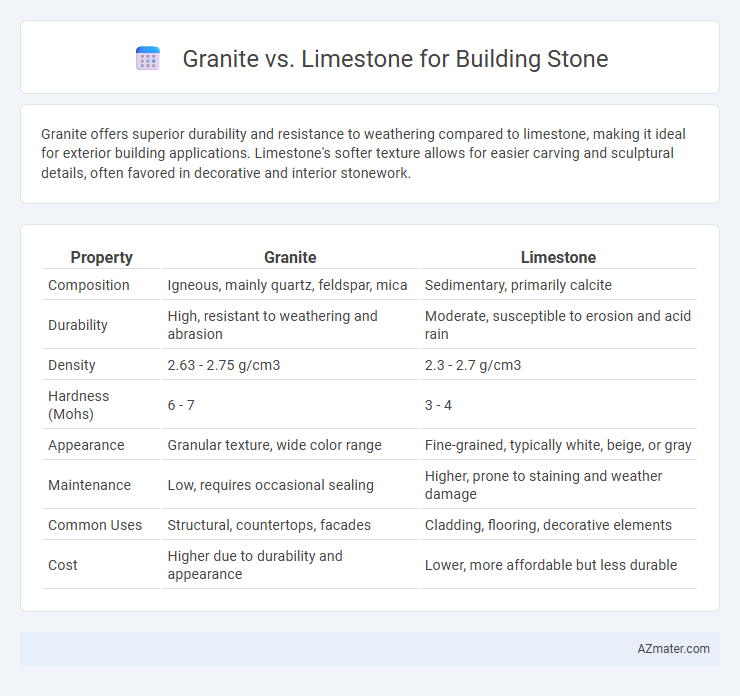Granite offers superior durability and resistance to weathering compared to limestone, making it ideal for exterior building applications. Limestone's softer texture allows for easier carving and sculptural details, often favored in decorative and interior stonework.
Table of Comparison
| Property | Granite | Limestone |
|---|---|---|
| Composition | Igneous, mainly quartz, feldspar, mica | Sedimentary, primarily calcite |
| Durability | High, resistant to weathering and abrasion | Moderate, susceptible to erosion and acid rain |
| Density | 2.63 - 2.75 g/cm3 | 2.3 - 2.7 g/cm3 |
| Hardness (Mohs) | 6 - 7 | 3 - 4 |
| Appearance | Granular texture, wide color range | Fine-grained, typically white, beige, or gray |
| Maintenance | Low, requires occasional sealing | Higher, prone to staining and weather damage |
| Common Uses | Structural, countertops, facades | Cladding, flooring, decorative elements |
| Cost | Higher due to durability and appearance | Lower, more affordable but less durable |
Introduction to Building Stones: Granite vs Limestone
Granite and limestone are two widely used building stones, each offering distinct structural and aesthetic benefits. Granite is a durable, coarse-grained igneous rock renowned for its hardness and resistance to weathering, making it ideal for exterior facades and heavy-load applications. Limestone, a sedimentary rock primarily composed of calcite, provides a softer, more workable surface commonly favored for decorative elements and interior cladding.
Geological Formation of Granite and Limestone
Granite forms from the slow cooling and solidification of magma deep within the Earth's crust, resulting in a coarse-grained, igneous rock composed primarily of quartz, feldspar, and mica. Limestone is a sedimentary rock primarily composed of calcium carbonate, often formed through the accumulation and compaction of marine organism shells and skeletal fragments in shallow, warm marine environments. The geological formation processes give granite superior durability and density compared to the more porous and chemically reactive nature of limestone.
Physical Properties Comparison
Granite exhibits significantly higher hardness, typically around 6-7 on the Mohs scale, compared to limestone's 3-4, making granite more resistant to scratching and abrasion. The density of granite averages 2.75 g/cm3, which is greater than limestone's average density of 2.3 g/cm3, contributing to its superior load-bearing capacity and durability. Granite's low porosity and high compressive strength, often exceeding 200 MPa, contrast with limestone's higher porosity and compressive strength typically ranging between 30-250 MPa, influencing their suitability for different structural applications.
Durability and Weather Resistance
Granite exhibits superior durability and weather resistance compared to limestone due to its dense, interlocking crystal structure, making it highly resistant to abrasion, erosion, and chemical weathering. Limestone, composed mainly of calcium carbonate, is more porous and susceptible to acid rain, freeze-thaw cycles, and surface degradation over time. Choosing granite for building stone ensures enhanced longevity in harsh environmental conditions, while limestone requires more maintenance and protective treatments to preserve its structural integrity.
Appearance and Color Variations
Granite features a granular texture with a wide range of colors including white, pink, gray, and black, offering a bold and speckled appearance ideal for dynamic architectural elements. Limestone typically presents in softer, muted tones such as beige, cream, and light gray, with a more uniform and subtle texture that lends a classic and elegant look to building facades. The contrasting appearance and color variations between granite's vibrant patterns and limestone's consistent hues influence their selection for both aesthetic and design purposes in construction.
Workability and Ease of Installation
Granite, known for its hardness and durability with a Mohs hardness of 6-7, presents challenges in workability due to its dense crystalline structure, requiring specialized tools and more labor-intensive cutting and shaping processes. Limestone, typically softer with a Mohs hardness of 3-4, offers greater ease of installation as it can be more easily cut, carved, and manipulated on-site, making it a preferred choice for intricate architectural details and faster construction timelines. The choice between granite and limestone ultimately depends on the specific project requirements, balancing the need for durability against the benefits of smoother handling and installation efficiency.
Cost Differences and Budget Considerations
Granite generally costs between $40 to $100 per square foot, making it a more expensive option compared to limestone, which ranges from $30 to $70 per square foot. The higher price of granite is due to its durability, low porosity, and resistance to weathering, which reduce long-term maintenance costs. Budget considerations should include not only the initial installation price but also the lifecycle expenses, as limestone may require more frequent sealing and repairs over time.
Environmental Impact and Sustainability
Granite, known for its durability and low porosity, requires extensive quarrying processes that consume significant energy and produce considerable waste, impacting ecosystems negatively. Limestone, being softer and more abundant, demands less energy for extraction but is prone to higher CO2 emissions during processing and can contribute to habitat disruption. Sustainable building choices prioritize quarry rehabilitation, reduced carbon footprints, and lifecycle assessments, where limestone's recyclability and lower embodied energy often present a greener alternative to granite.
Common Applications in Construction
Granite is widely used in construction for countertops, flooring, and exterior cladding due to its durability, resistance to weathering, and aesthetic appeal, making it ideal for high-traffic areas and structural applications. Limestone is favored for interior flooring, wall cladding, and decorative elements because of its softer texture and ease of carving, though it requires sealing to protect against moisture and stains. Both stones contribute to sustainable building practices, with granite offering long-lasting strength and limestone providing excellent thermal insulation properties for energy-efficient structures.
Which Stone Should You Choose?
Granite offers superior durability and resistance to weathering, making it a preferred choice for exterior building applications and high-traffic areas. Limestone provides a softer, more traditional aesthetic with excellent insulating properties but is more susceptible to erosion and staining. Selecting between granite and limestone depends on your project's environmental exposure, desired texture, and long-term maintenance considerations.

Infographic: Granite vs Limestone for Building Stone
 azmater.com
azmater.com